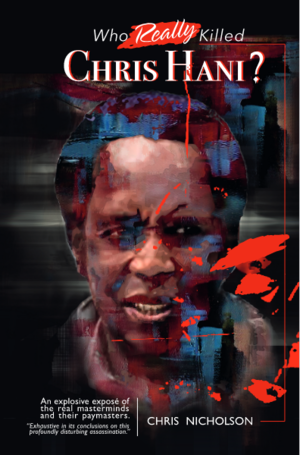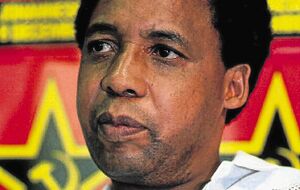Document:Who Really Killed Chris Hani?
| "Apart from Chris Hani’s murder, we deal with five others, spread over three decades: Patrice Lumumba in September 1961; Dag Hammarskjöld on 18 September 1961; Olof Palme on 28 February 1986; Bernt Carlsson on 21 December 1988; and Anton Lubowski on 12 September 1989." |
Subjects: Bernt Carlsson, Dag Hammarskjöld, Chris Hani, Anton Lubowski, Patrice Lumumba, Olof Palme
Source: Link
★ Start a Discussion about this document
Who Really Killed Chris Hani?
Blurb

This book is a most explosive account of the real masterminds behind the murder of Chris Hani on 10 April 1993. South Africa’s first non-racial president, President Nelson Mandela, eulogised Hani’s role in the birth of the new South Africa, thundering that ‘the enemies of change demonised Chris to the end, helping to create the climate in which our nation was robbed of one of its giants …’
Mandela spoke of how that fateful day of Hani’s brutal murder was indelibly etched on the hearts of all freedom-loving people, and how no-one would be satisfied ‘until the truth about his death is known’. Retired judge, Chris Nicholson, meticulously challenges the bizarre narrative that a mad right-wing Pole with pale blue, staring eyes, Janusz Waluś, acting in concert with a white supremacist with a handlebar moustache, Clive Derby-Lewis, committed the murder, without outside assistance.
With fanatical zeal Nicholson investigates the ‘enemies of change’, who contributed to his murder. His foes in the intelligence world are probed, including the sinister South African Institute for Maritime Research, as are the captains of industry, with their vast accumulated wealth, who feared his commitment to the socialist aims of the Freedom Charter. Finally, the spotlight is ruthlessly shone on Hani’s rivals and enemies within the ANC.
Particularly fascinating is Nicholson’s exploration of the historical precedents of other heroes who were murdered for fighting the plundering of the corporates, and for trying to redistribute Africa’s wealth to its people. In an amazing set of revelations, the author explores the deaths, over three decades, of Patrice Lumumba in September 1961; Dag Hammarskjöld on 18 September 1961; Olof Palme on 28 February 1986; Bernt Carlsson on 21 December 1988 and, finally, Anton Lubowski on 12 September 1989.
Although these killings occurred over a 30-year period, Nicholson shows, in true judicial fashion, how the motives and patterns of behaviour of the perpetrators of those murders materially assist in locating the true accomplices in Hani’s murder. Only a writer of the most courageous talent could have crafted this enthralling account.
Extract
From Chapter 5 – "Six similar sinister scandals":
Apart from Chris Hani’s murder, we deal with five others, spread over three decades: Patrice Lumumba in September 1961; Dag Hammarskjöld on 18 September 1961; Olof Palme on 28 February 1986; Bernt Carlsson on 21 December 1988; and Anton Lubowski on 12 September 1989.
As is apparent, 25 years separated the first two murders from the others, but thereafter the others occurred within seven years. There are two groups: those who were assassinated by gunmen on the ground, that is, Lumumba, Hani, Lubowski and Palme; and those who died as a result of air crashes, Hammarskjöld and Carlsson.
In the normal course of events, the fact that an accused committed another crime is irrelevant and inadmissible. However, the law has on occasion admitted evidence of other offences that show the accused has acted in a similar way before and is therefore more likely to have done what is alleged against him. This is then called a similar fact case.
Just by way of explanation, one classic case is the Rex v Smith ‘brides in the bath’ case in 1915. The accused, Arthur Smith, had committed multiple bigamy offences and three of his wealthy brides had died after alleged epileptic attacks in their baths. In each case, Smith stood to inherit his bride’s estate. Although he could only be tried for his last wife’s murder, the prosecution used evidence of the deaths of the other two wives to establish Smith’s crime pattern. He was found guilty and sentenced to death.
To simplify the telling of this exposé, the deaths of Lumumba and Hammarskjöld will be referred to as the first two similar fact killings. The subsequent deaths are examined as further cases of similar fact evidence.
Patrice Lumumba, first prime minister of the Democratic Republic of Congo (DRC) when it achieved independence from Belgium in 1960, had a passionate desire to keep Congo’s wealth for the people. He was assassinated in 1961.
United Nations Secretary-General Dag Hammarskjöld espoused the ideal that the wealth of a country should be for the benefit of the people of that country. When corporate and other forces sought to oust Lumumba and defeat his socialist agenda, Hammarskjöld intervened. His mission was to assist the Congo achieve its potential after independence. He died in a plane crash in 1961 outside Ndola, Zambia. Most evidence points to a bomb on the plane or some other foul play.
The third victim and example of a similar fact case was that of Swedish Prime Minister Olof Palme, an avid anti-apartheid activist who raised funds for the anti-apartheid movement. In 1986 he was assassinated while on his way home from a movie.
In December 1988, Bernt Carlsson, United Nations Assistant Secretary-General, the fourth similar fact case, was persuaded to stop over in London on his way to the US. He then boarded Pan Am Flight 103, which exploded over Lockerbie in Scotland, killing all on board. Carlsson was also Commissioner-General for South West Africa – occupied Namibia – and was leading the process for independence. For 20 years before South Africa’s illegal rule ended, huge mining companies, horrified at the prospect of majority rule, proceeded to tear the biggest alluvial diamonds from the coastal sands and whip them out of the country. Carlsson was determined to take on the big companies and sue them for the wealth and resources being looted from Namibia in breach of United Nations law.
The last and fifth similar fact case relates to Windhoek advocate Anton Lubowski. He was working assiduously for the new Namibia’s future, including its mineral wealth, when he was gunned down outside his home in 1989. It seems that there were those who could not tolerate the future he was planning for the country.
Although these killings occurred over a 30-year period, the motives and patterns of behaviour of the culprits may assist in locating the accomplices in Hani’s murder.
No one could have expressed it better than Irish author SM Sigerson, author of the book on Michael Collins, quoted at the start of this chapter, when he said, ‘History repeats itself as do the methods used by those specialising in the elimination of leaders who unite people into a strong force for dignity, justice and self-determination.’
Afterword
In his Afterword to "Who Really Killed Chris Hani?", Judge Nicholson describes in detail how major publishers seemed to be colluding in suppressing publication of the book. Nicholson wrote:
- "Courts have decided that freedom of expression trumps all other rights as without it nobody, including the courts, would ever hear of breaches of other rights. So those who have attempted to suppress this book have prevented the world from discovering and prosecuting the criminals, who perpetrated the foul murders. In law we would describe them as accessories after the fact of these killings."[1]
About the author
Christopher Nicholson has lived all his life in KwaZulu-Natal in South Africa. He practised as a human rights lawyer assisting victims of apartheid before majority rule was won in 1994.
His efforts were recognised with two awards and he was appointed a high court judge in 1995.
He’s published eight books and a play. Two books were nominated for the Alan Paton prize in South Africa for non-fiction. He’s married with two daughters.
Kindle edition
"Who Really Killed Chris Hani?" is available here for download from Judge Nicholson's website.[2]
